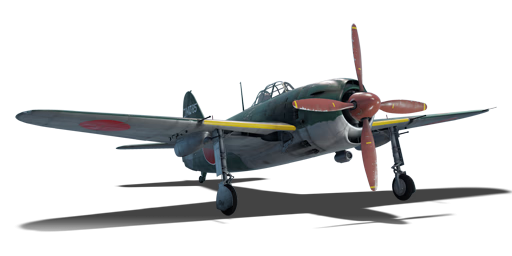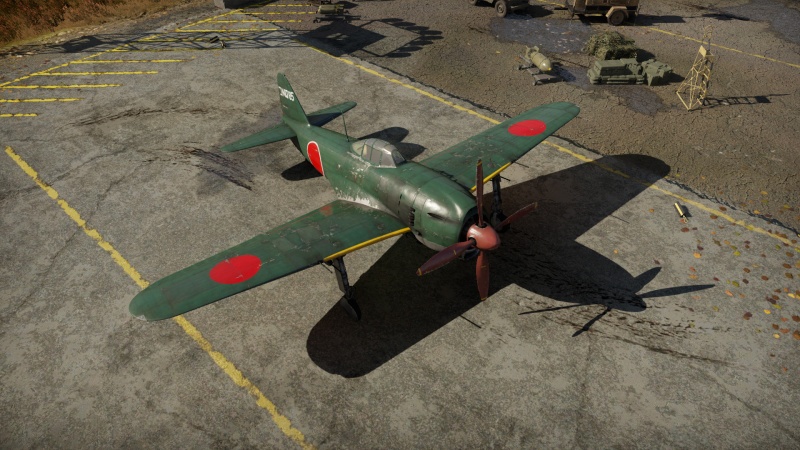Difference between revisions of "N1K1-Ja"
(→Survivability and armour) (Tag: Visual edit) |
|||
| Line 74: | Line 74: | ||
=== Survivability and armour === | === Survivability and armour === | ||
{{Specs-Avia-Armour}} | {{Specs-Avia-Armour}} | ||
| − | ''Examine the survivability of the aircraft. Note how vulnerable the structure is and how secure the pilot is, whether the fuel tanks are armoured, etc. Describe the armour, if there is any, and also mention the vulnerability of other critical aircraft systems.'' | + | <!-- ''Examine the survivability of the aircraft. Note how vulnerable the structure is and how secure the pilot is, whether the fuel tanks are armoured, etc. Describe the armour, if there is any, and also mention the vulnerability of other critical aircraft systems.'' --> |
* 70 mm Bulletproof glass - Armoured windscreen | * 70 mm Bulletproof glass - Armoured windscreen | ||
| Line 125: | Line 125: | ||
=== Pros and cons === | === Pros and cons === | ||
| − | ''Summarise and briefly evaluate the vehicle in terms of its characteristics and combat effectiveness. Mark its pros and cons in the bulleted list. Try not to use more than 6 points for each of the characteristics. Avoid using categorical definitions such as "bad", "good" and the like - use substitutions with softer forms such as "inadequate" and "effective".'' | + | <!-- ''Summarise and briefly evaluate the vehicle in terms of its characteristics and combat effectiveness. Mark its pros and cons in the bulleted list. Try not to use more than 6 points for each of the characteristics. Avoid using categorical definitions such as "bad", "good" and the like - use substitutions with softer forms such as "inadequate" and "effective".'' --> |
'''Pros:''' | '''Pros:''' | ||
| − | * Reasonable manoeuvrability at medium speeds (300 | + | * Reasonable manoeuvrability at medium speeds (300-500 km/h) |
* Great energy retention | * Great energy retention | ||
* Solid acceleration once upgraded | * Solid acceleration once upgraded | ||
* Combat flaps are efficient while in dogfighting | * Combat flaps are efficient while in dogfighting | ||
* Decent rate of climb | * Decent rate of climb | ||
| − | * Powerful armament of | + | * Powerful armament of 4 x 20 mm cannons plus 2 x 7.7 mm MGs |
| − | |||
* Relatively good diving characteristics for a Japanese aircraft | * Relatively good diving characteristics for a Japanese aircraft | ||
| Line 143: | Line 142: | ||
* Severely stiffens at higher speeds | * Severely stiffens at higher speeds | ||
* Can be outmanoeuvred easily by the fighters at its tier if not used correctly | * Can be outmanoeuvred easily by the fighters at its tier if not used correctly | ||
| − | * Unless approached correctly, completely outclassed by the Spitfire Mk | + | * Unless approached correctly, completely outclassed by the Spitfire Mk IX and F8Fs |
* Ammo capacity of cannons is quite small, only 100 RPG which is far less than its later models | * Ammo capacity of cannons is quite small, only 100 RPG which is far less than its later models | ||
| − | |||
* Weak stock belts, which can only be unlocked at tier III | * Weak stock belts, which can only be unlocked at tier III | ||
| − | |||
* Can catch on fire easily, and often gets destroyed in the process | * Can catch on fire easily, and often gets destroyed in the process | ||
| − | * Often faces early jets such as He | + | * Often faces early jets such as He 162 |
== History == | == History == | ||
Revision as of 10:27, 10 January 2021
| This page is about the Japanese fighter N1K1-Ja. For other uses, see N1K (Family). |
Contents
Description
The N1K1-Ja is a rank IV Japanese fighter with a battle rating of 5.3 (AB/RB/SB). It was introduced in Update 1.59 "Flaming Arrows".
General info
Flight performance
| Characteristics | Max Speed (km/h at 6,200 m) |
Max altitude (metres) |
Turn time (seconds) |
Rate of climb (metres/second) |
Take-off run (metres) | |||
|---|---|---|---|---|---|---|---|---|
| AB | RB | AB | RB | AB | RB | |||
| Stock | 591 | 576 | 10000 | 18.8 | 19.4 | 13.6 | 13.6 | 300 |
| Upgraded | 637 | 614 | 17.8 | 18.0 | 23.1 | 17.8 | ||
Details
| Features | ||||
|---|---|---|---|---|
| Combat flaps | Take-off flaps | Landing flaps | Air brakes | Arrestor gear |
| ✓ | ✓ | ✓ | X | X |
| Limits | ||||||
|---|---|---|---|---|---|---|
| Wings (km/h) | Gear (km/h) | Flaps (km/h) | Max Static G | |||
| Combat | Take-off | Landing | + | - | ||
| 780 | 280 | 520 | 390 | 390 | ~13 | ~6 |
| Optimal velocities (km/h) | |||
|---|---|---|---|
| Ailerons | Rudder | Elevators | Radiator |
| < 430 | < 460 | < 400 | > 324 |
Survivability and armour
- 70 mm Bulletproof glass - Armoured windscreen
- 12 mm Steel plate in pilot's seat
Modifications and economy
Armaments
Offensive armament
The N1K1-Ja is armed with:
- 4 x 20 mm Type 99 Model 2 cannons, wing-mounted (100 rpg = 400 total)
- 2 x 7.7 mm Type 97 navy machine guns, nose-mounted (550 rpg = 1,100 total)
Suspended armament
The N1K1-Ja can be outfitted with the following ordnance:
- Without load
- 2 x 60 kg Navy Type 97 Number 6 bombs (120 kg total)
Usage in battles
Describe the tactics of playing in the aircraft, the features of using aircraft in a team and advice on tactics. Refrain from creating a "guide" - do not impose a single point of view, but instead, give the reader food for thought. Examine the most dangerous enemies and give recommendations on fighting them. If necessary, note the specifics of the game in different modes (AB, RB, SB).
Manual Engine Control
| MEC elements | ||||||
|---|---|---|---|---|---|---|
| Mixer | Pitch | Radiator | Supercharger | Turbocharger | ||
| Oil | Water | Type | ||||
| Controllable | Controllable Not auto controlled |
Controllable Not auto controlled |
Controllable Not auto controlled |
Separate | Controllable 2 gears |
Not controllable |
Pros and cons
Pros:
- Reasonable manoeuvrability at medium speeds (300-500 km/h)
- Great energy retention
- Solid acceleration once upgraded
- Combat flaps are efficient while in dogfighting
- Decent rate of climb
- Powerful armament of 4 x 20 mm cannons plus 2 x 7.7 mm MGs
- Relatively good diving characteristics for a Japanese aircraft
Cons:
- Mediocre roll rate
- Severely stiffens at higher speeds
- Can be outmanoeuvred easily by the fighters at its tier if not used correctly
- Unless approached correctly, completely outclassed by the Spitfire Mk IX and F8Fs
- Ammo capacity of cannons is quite small, only 100 RPG which is far less than its later models
- Weak stock belts, which can only be unlocked at tier III
- Can catch on fire easily, and often gets destroyed in the process
- Often faces early jets such as He 162
History
In late 1941, as the 15-shi was still in development, some engineers were already concerned and proposed it would also be the basis of a formidable land-based fighter and a land-based version was produced as a private venture by the company. This version flew on 27 December 1942 powered by a Nakajima NK9A Homare 11 18-cylinder radial engine, replacing the less powerful Mitsubishi MK4C Kasei 13 of the N1K1.
As the navy canceled its orders on the Kyōfū, Kawanishi was opted with 3 choices:
- Repurpose the H8K, Type 2 Flying Boat as a land-based bomber
- Create a new carrier based fighter
- Repurpose the 15-shi (N1K, Kyōfū) as a land-based fighter
Kawanishi decided to further promote development of the land-based fighter version. Even though some Navy engineers showed concern that Kawanishi wouldn't be a suited designer of land-based planes due the few experience they have on land, the plane still showed great potential and was quickly evaluated by the Navy. Aside from engine problems stemming from rushed engine development and some landing gear issues, the Navy was thoroughly impressed as its speed was far faster than the A6M and its maximum range was beyond that of the Raiden and ordered its production as the N1K1-J, Shiden.
Media
See also
- Related Development
- N1K1 - (Kyofu Model 11; Base hydroplane model)
- N1K1-Ja - (Shiden Model 11A; N1K1-J with 7.7mm's removed from the fuselage and 4x20mm in the wings)
- N1K2-J - (Shiden Kai Model 21; Redesigned wings and fuselage)
- N1K2-Ja - (Shiden Kai Model 21A; More powerful engine, larger prop)
External links
| Kawanishi Aircraft Company (川西航空機) | |
|---|---|
| Fighters | J6K1 |
| N1K | N1K1-Ja · N1K2-J · N1K2-Ja |
| Bombers | H6K4 · H8K2 · H8K3 |
| Hydroplane | N1K1 · E7K2 |
| Japan fighters | |
|---|---|
| Navy | |
| Carrier-based fighter | |
| A5M | A5M4 · Hagiri's A5M4 |
| A6M | A6M2 mod. 11 · A6M2 · A6M3 · A6M3 mod. 22 · A6M3 mod. 22Ko · A6M5 · A6M5 Ko · A6M5 otsu · A6M5 Hei · A6M6c |
| A7He | A7He1* |
| A7M | A7M1 (NK9H) · A7M2 |
| Land-based Fighter | |
| J2M | J2M2 · J2M3 · J2M4 Kai · J2M5 · J2M5 (30 mm) |
| J6K | J6K1 |
| J7W | J7W1 |
| N1K-J | N1K1-Ja · N1K2-J · N1K2-Ja |
| Fighter seaplane | |
| N1K | N1K1 |
| A6M-N | A6M2-N |
| Army | |
| Ki-10 | Ki-10-I · Ki-10-I C · Ki-10-II · Ki-10-II C |
| Ki-27 | Ki-27 otsu · Ki-27 otsu Tachiarai |
| Ki-43 | Ki-43-I · Ki-43-II · Ki-43-III otsu |
| Ki-44 | Ki-44-I · Ki-44-I 34 · Ki-44-II otsu · Ki-44-II hei |
| Ki-61 | Ki-61-I ko · Ki-61-I otsu · Ki-61-I hei · Tada's Ki-61-I hei · Ki-61-I tei · Ki-61-II Otsu Kai |
| Ki-84 | Ki-84 ko · Ki-84 otsu · Ki-84 hei |
| Ki-87 | Ki-87 |
| Ki-94 | Ki-94-II |
| Ki-100 | Ki-100 · Ki-100-II |
| Other countries | ▅F4U-1A · ▅P-51C-11-NT · ▅Bf 109 E-7 · ▅Fw 190 A-5 |
| *Imported designation of the He 112 (A6M was in development - A7M would take A7 designation after the cancelation of the A7He) | |





